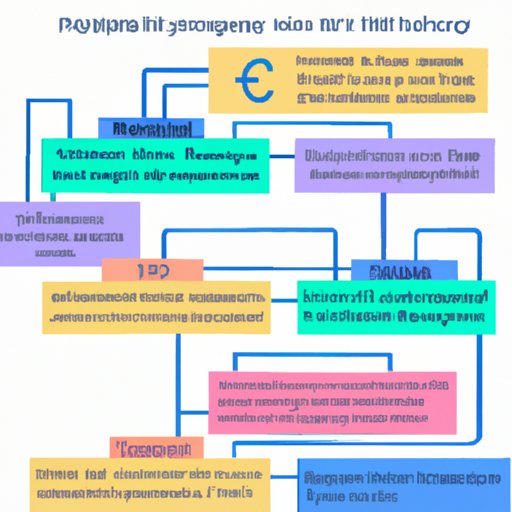Introduction: What is Crypto and How Did It Start?
Crypto, or cryptocurrency, is a digital asset designed to work as a medium of exchange that uses cryptography to secure transactions, control the creation of additional units, and verify transfers of assets. It first emerged in 2009 with the release of Bitcoin, which was created by an unknown person or group of people using the pseudonym Satoshi Nakamoto. Since then, crypto has grown rapidly, becoming one of the most popular and widely used technologies in the world.
A Timeline of Key Events in the History of Crypto
Crypto has come a long way since its inception. Here’s a timeline of key events in the history of crypto:
Early Developments (1970s-1990s)
The concept of digital currency can be traced back to the 1970s when computer scientist David Chaum developed the idea of “blind signatures” for secure financial transactions. In the 1990s, other forms of digital cash began to emerge, such as DigiCash and e-gold. However, these early attempts at digital currency failed due to lack of widespread adoption.
The Bitcoin Revolution (2008-2010)
In 2008, a mysterious figure known as Satoshi Nakamoto released a white paper entitled “Bitcoin: A Peer-to-Peer Electronic Cash System.” The paper outlined a new decentralized digital currency system based on blockchain technology. This marked the beginning of the crypto revolution.
In 2009, the first Bitcoin block was mined, followed by the launch of the first Bitcoin exchange in 2010. This led to the growth of a vibrant community of developers and investors who were determined to make crypto a mainstream technology.
Expansion and Adoption (2011-Present)
By 2011, other cryptocurrencies had been created, such as Litecoin and Namecoin. This marked the start of the altcoin era, which saw the rapid growth of the crypto market. As more and more people became interested in crypto, the price of Bitcoin and other cryptocurrencies began to rise.
Over the years, crypto has become increasingly mainstream, with governments, banks, and businesses around the world embracing the technology. Today, crypto is being used for a variety of purposes, from payments and remittances to investments and trading.

From Whitepapers to the World of Crypto
To better understand how crypto works, it’s important to look at the underlying technology. Here’s an overview of some of the key concepts behind crypto:
Satoshi Nakamoto’s White Paper
Satoshi Nakamoto’s white paper is the foundation for the entire crypto ecosystem. In it, he outlines a new type of digital currency system that is powered by a decentralized network of computers. The system is secured through cryptography and is designed to be resistant to fraud and manipulation.
Blockchain Technology
Blockchain is the underlying technology behind crypto. It is a distributed ledger that records all transactions and is secured using cryptography. Transactions are verified and stored on the blockchain, creating a permanent record of all activity.
Different Types of Cryptocurrencies
There are hundreds of different types of cryptocurrencies, each with its own unique features and use cases. The most popular cryptocurrencies include Bitcoin, Ethereum, Litecoin, and Ripple. Other types of crypto include stablecoins, privacy coins, utility tokens, and security tokens.
Crypto Pioneer Profiles: The People Behind the Technology
Crypto wouldn’t be where it is today without the hard work and dedication of a few key individuals. Here are some of the most influential people in the world of crypto:
Satoshi Nakamoto
Satoshi Nakamoto is the creator of Bitcoin and the author of the original white paper. While his identity remains a mystery, his impact on the world of crypto cannot be overstated. He is credited with inventing the blockchain, which has revolutionized the way we think about money and finance.
Vitalik Buterin
Vitalik Buterin is one of the most influential figures in the world of crypto. He is the co-founder of Ethereum, the second-largest cryptocurrency. He is also a major proponent of decentralization and has made significant contributions to the development of blockchain technology.
Other Pioneers
There are many other pioneers in the world of crypto who have made significant contributions. These include Charlie Lee (creator of Litecoin), Nick Szabo (creator of smart contracts), and Gavin Andresen (lead developer of Bitcoin). Each of these individuals has played an important role in the development and adoption of crypto.

An Overview of Crypto Economics
Crypto economics is a complex field that involves understanding the supply and demand of cryptocurrencies, their price volatility, and the incentives for miners. Here’s an overview of some of the key concepts:
Mining
Mining is the process of verifying and recording transactions on the blockchain. Miners are rewarded with newly created coins for their efforts. The amount of rewards received depends on the amount of computing power dedicated to mining.
Supply and Demand
The price of crypto is determined by the forces of supply and demand. If there is high demand and low supply, the price will go up. If there is low demand and high supply, the price will go down.
Price Volatility
Cryptocurrencies are known for their extreme price volatility. Prices can change drastically in a short period of time, making them risky investments. This has caused some investors to be wary of investing in crypto.

Examining the Regulatory Climate for Crypto
Regulations play an important role in the world of crypto. Governments and regulators have begun to take notice of the growing industry and have implemented various regulations to protect investors and ensure compliance. Here’s an overview of the current regulations and potential regulations:
Current Regulations
Most countries have implemented some form of regulation for crypto. In the US, the Securities and Exchange Commission (SEC) regulates the sale and trading of crypto assets. Other countries have implemented similar regulations, such as Japan, South Korea, and the UK.
Potential Regulations
Governments are continuing to monitor the crypto space and are considering introducing additional regulations. These could include rules regarding taxation, anti-money laundering, and investor protection. It is likely that more regulations will be introduced in the future.
Impact on Investors
Regulations can have a major impact on investors. For example, the SEC’s regulations require exchanges to register with the agency and adhere to certain standards. This makes it easier for investors to know that their funds are protected and that they are dealing with legitimate exchanges.
Exploring the Social Impact of Crypto
Crypto has had a profound impact on society. Here are some of the ways in which crypto has changed the world:
Financial Inclusion
Crypto has enabled people in developing countries to access financial services that were previously unavailable. It has enabled millions of people to send and receive money quickly and securely, regardless of location or economic status.
Security and Privacy
Crypto is more secure than traditional payment systems, as it uses cryptography to protect users’ data. It also offers users greater privacy, as transactions can be made without revealing personal information.
Decentralization
Crypto is decentralized, meaning that no single entity controls it. This makes it resistant to censorship and government interference, giving users more freedom and control over their funds.

Analyzing the Technical Architecture of Cryptocurrencies
Cryptocurrencies are built on top of complex technical architectures. Here are some of the key concepts to understand:
Consensus Protocols
Consensus protocols are algorithms that enable nodes in a network to agree on a single version of the truth. They are used to validate transactions and ensure that the blockchain is secure and immutable.
Smart Contracts
Smart contracts are digital contracts that are self-executing and enforced by code. They enable the automation of complex processes, such as payments and escrow services.
Cryptography
Cryptography is the science of securing information. It is used to protect crypto transactions and ensure that only authorized users can access data. It is also used to secure wallets, ensuring that funds are safe from hackers.
Conclusion
Crypto has come a long way since its inception. From Satoshi Nakamoto’s white paper to the emergence of blockchain technology, crypto has revolutionized the way we think about money and finance. With more and more governments and businesses embracing the technology, the future of crypto looks brighter than ever.
This article provided an overview of how crypto started and how it has evolved over the years. It examined the regulatory climate, social impact, and technical architecture of cryptocurrencies, as well as profiles of key pioneers in the industry. While there are still many challenges ahead, it is clear that crypto has the potential to change the world.
(Note: Is this article not meeting your expectations? Do you have knowledge or insights to share? Unlock new opportunities and expand your reach by joining our authors team. Click Registration to join us and share your expertise with our readers.)
